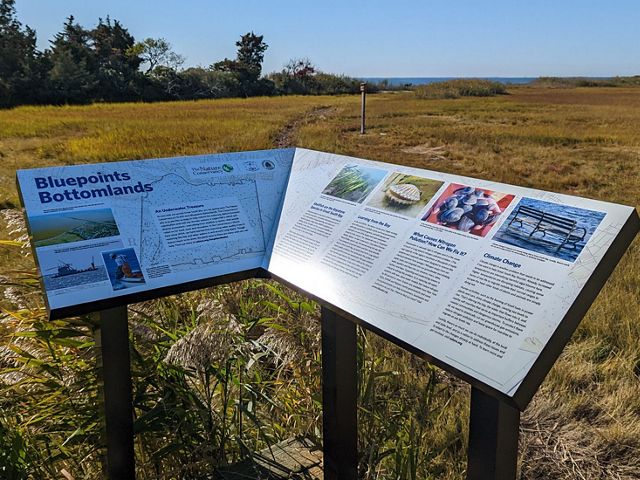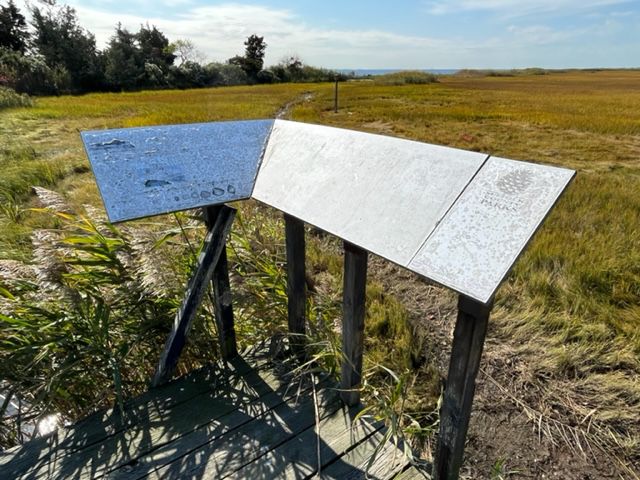New Sign at the Long Island Maritime Museum Honors Ongoing Campaign to Improve Water Quality
Great South Bay Pivotal to The Nature Conservancy’s Work Across Long Island
Media Contacts
-
May Yeung
The Nature Conservancy
Phone: +1 (347) 387-4250
Email: may.yeung@tnc.org,
Visitors to the Long Island Maritime Museum may remember an old wooden sign at the end of a pier there, overlooking marshes that extend out into the Great South Bay. Installed nearly 20 years ago and weathered by natural elements, it was replaced today by The Nature Conservancy in partnership with Suffolk County Parks Department. Now illustrated in full-color, the new sign tells the important history of the 13,425-acre Bluepoint Bottomlands, underwater lands that changed the course of The Nature Conservancy’s work on Long Island over 15 years ago.
What started as a mission to “jump-start Mother Nature” by restoring depleted hard clam populations in the Great South Bay became a public information campaign to reduce nitrogen pollution. That paved the way for programs today that allow homeowners to replace their polluting septic system with non-polluting ones, as well as public investments to expand and improve sewers island-wide.
“What we learned was that nitrogen and other pollutants had been leaking into our ground water aquifers and ultimately flowing to our bays for decades.” said Carl LoBue, Oceans Director of the Nature Conservancy in New York. “It became clear that this wasn’t just a Great South Bay problem, it was something for us to resolve across Long Island, and that we needed to address nitrogen pollution at its source, which has meant over a decade of working with key partners at the state and local level.”
Quote: Carl LoBue
"It became clear that this wasn’t just a Great South Bay problem, it was something for us to resolve across Long Island, and that we needed to address nitrogen pollution at its source."
“Museums play a special role in society by educating and informing about the past.” said Terry Lister-Blitman, Executive Director of the Long Island Maritime Museum. “By visiting this Museum guests experience history and its effects on the health of the Great South Bay and its surrounding estuary – both of which played pivotal roles in the story of Long Island. We are so happy to see this new updated sign provided by The Nature Conservancy. It’s another educational resource for Museum visitors to enjoy.”
Bluepoint Bottomlands makes up about 25% of the Great South Bay, which was once home to the famed Blue Point oyster and the source of half the clams eaten in the United States just 50 years ago. Overharvesting, overdevelopment, and pollution have each contributed to the depletion of shellfish in the bay. Research supported by the Nature Conservancy and partners including Stony Brook University found that excess nitrogen from polluting septic systems is a major factor leading to harmful algae blooms. The reoccurring algal blooms in nitrogen-rich waters make it hard for shellfish recovery to take hold, and choke out other marine life, such as eelgrass.
The public information campaign and partnerships that followed brought together local scientists, advocacy groups, public officials, and homeowners to reduce nitrogen pollution and improve water quality on Long Island. A recent initiative by Governor Kathy Hochul, the Suffolk County Coastal Resiliency Initiative will upgrade sewer system connections for more than 5,000 homes in Suffolk County to prevent nitrogen and other contaminants from polluting Long Island's coastal waters. For more information on what causes nitrogen pollution and how to fix it, visit protectliwater.org.
The Nature Conservancy is a global conservation organization dedicated to conserving the lands and waters on which all life depends. Guided by science, we create innovative, on-the-ground solutions to our world’s toughest challenges so that nature and people can thrive together. We are tackling climate change, conserving lands, waters and oceans at an unprecedented scale, providing food and water sustainably and helping make cities more sustainable. The Nature Conservancy is working to make a lasting difference around the world in 77 countries and territories (41 by direct conservation impact and 36 through partners) through a collaborative approach that engages local communities, governments, the private sector, and other partners. To learn more, visit nature.org or follow @nature_press on X.

